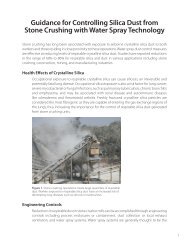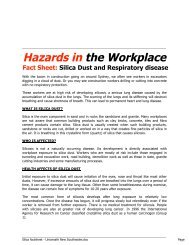Safety & Health in the Stone Crushing Industry - Occupational ...
Safety & Health in the Stone Crushing Industry - Occupational ...
Safety & Health in the Stone Crushing Industry - Occupational ...
Create successful ePaper yourself
Turn your PDF publications into a flip-book with our unique Google optimized e-Paper software.
33<br />
Noise is mostly produced by ei<strong>the</strong>r impact or vibration. This happens at <strong>the</strong> follow<strong>in</strong>g locations <strong>in</strong> a<br />
stone crush<strong>in</strong>g unit:<br />
−<br />
−<br />
−<br />
The crushers <strong>the</strong>mselves(Primary and Secondary) when boulders are crushed and<br />
transported along conveyors<br />
The boulder load<strong>in</strong>g po<strong>in</strong>t when boulders are fed <strong>in</strong>to receiv<strong>in</strong>g pit<br />
The sieves when <strong>the</strong> gravel is sorted<br />
Noise can have <strong>the</strong> follow<strong>in</strong>g effects on <strong>the</strong> health of workers and owners:<br />
−<br />
−<br />
−<br />
−<br />
−<br />
Distortion of sounds (hear<strong>in</strong>g someth<strong>in</strong>g, but not understand<strong>in</strong>g)<br />
Temporary or permanent hear<strong>in</strong>g loss<br />
A cont<strong>in</strong>ual r<strong>in</strong>g<strong>in</strong>g <strong>in</strong> <strong>the</strong> ears for which <strong>the</strong>re is no cure ("t<strong>in</strong>nitus" <strong>in</strong> medical terms)<br />
Quickened pulse rate, <strong>in</strong>creased blood<br />
pressure and a narrow<strong>in</strong>g of <strong>the</strong> blood vessels<br />
Abnormal secretions of hormones, muscle<br />
tens<strong>in</strong>g, nervousness, sleeplessness, fatigue<br />
Solutions to protect health<br />
Conduct regular ma<strong>in</strong>tenance: replace all<br />
unbalanced or loose parts of mach<strong>in</strong>es<br />
Lubricate turn<strong>in</strong>g mach<strong>in</strong>e parts regularly<br />
Replace metal parts with quieter plastic parts if<br />
possible, for <strong>in</strong>stance rollers, washers<br />
Mach<strong>in</strong>es which vibrate should be mounted on<br />
heavy, rigid bases to prevent vibration<br />
Consider putt<strong>in</strong>g heavy rubber or plastic mats on<br />
places where impact or mach<strong>in</strong>e parts or boulders<br />
cause noise<br />
Enclose especially noisy mach<strong>in</strong>e parts with punctured metal plates, best <strong>in</strong> several layers so<br />
<strong>the</strong> sound gets "trapped"<br />
Position workers away from noise sources as much as possible<br />
Provide hear<strong>in</strong>g protection for workers, such as earplugs and earmuffs, tra<strong>in</strong> workers on <strong>the</strong><br />
purpose, proper fitt<strong>in</strong>g, and care of hear<strong>in</strong>g protectors and provide cont<strong>in</strong>uous monitor<strong>in</strong>g of<br />
employee noise-exposure levels if possible. However, <strong>in</strong> that case collaboration with experts<br />
<strong>in</strong> occupational health is needed for advice<br />
Always use properly shaped and sharpened cutt<strong>in</strong>g tools so you need less force to cut th<strong>in</strong>gs.<br />
We show here a noise map of a typical stone crush<strong>in</strong>g unit. The areas <strong>in</strong> <strong>the</strong> centre, <strong>in</strong> red (dark grey <strong>in</strong><br />
<strong>the</strong> black & white pr<strong>in</strong>t) <strong>in</strong>dicate areas with more that 90 decibel of noise (measure <strong>in</strong> decibel on scale<br />
A, adapted to <strong>the</strong> capacities of <strong>the</strong> human ear, abbreviated dB (A)) where hear<strong>in</strong>g protection needs to<br />
be worn. It is <strong>the</strong> area around <strong>the</strong> crushers and <strong>the</strong> sieve. The next area around it, <strong>in</strong> p<strong>in</strong>k (gray) has<br />
noise levels over 85 dB(A) where hear<strong>in</strong>g protection should be provided. Noise levels above 85 dB(A),<br />
and def<strong>in</strong>itely above 90 db(A), are dangerous and will lead to noise-<strong>in</strong>duced hear<strong>in</strong>g loss after a short<br />
time. They are also a risk factor to develop high blood pressure, nervousness, and irritation, all of<br />
which can <strong>in</strong>crease <strong>the</strong> risk to have heart diseases such as heart attack, or stroke.







